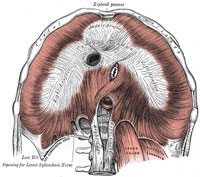 As our knowledge of the core and proper lumbopelvic stabilization continues to improve, our understanding of the diaphragm’s function as a postural muscle continues to improve as well. We know that as the diaphragm contracts during inspiration, intra-abdominal pressure increases, and lumbar spine stiffness is increased. During activities the diaphragm acts in coordination with the abdominal muscles, spinal muscles, and pelvic floor to create lumbar stability in all directions. This is what Stuart McGill refers to as “360 degree stiffness.”
As our knowledge of the core and proper lumbopelvic stabilization continues to improve, our understanding of the diaphragm’s function as a postural muscle continues to improve as well. We know that as the diaphragm contracts during inspiration, intra-abdominal pressure increases, and lumbar spine stiffness is increased. During activities the diaphragm acts in coordination with the abdominal muscles, spinal muscles, and pelvic floor to create lumbar stability in all directions. This is what Stuart McGill refers to as “360 degree stiffness.”
Individuals with Low Back Pain Breathe Differently While Lifting
A recent study publish in JOSPT sought to assess if people with back pain breathe differently when trying to lift an object. The examiners looked at 32 subjects with chronic, nonspecific low back pain for at least 1 year and compared their breathing performance to a group of 30 healthy controls.
Results of the study revealed that individuals with low back pain lifted objects with 7.2% more air in their lungs than healthy individuals.
Several studies have shown that increases in inspired lung volume correlate to increases in intra-abdominal pressure and subsequent increase in lumbar spine stability. The results of this study are interesting. My first thought was that the study was going to show the exact opposite – that individuals with low back pain would have LESS air in their lungs, thus making the diaphragm less effective at stabilizing the lumbar spine.
This could be a protective mechanism in the subjects with low back pain. They could be breathing this way as a compensatory mechanism to assist the other core musculature that may be performing poorly. We are unable to know exactly why this difference exists and wether or not it is causative or compensatory.
However, if we dig a little deeper into the results of the study, another interesting finding emerges. Not only do individuals with low back pain have a different amount of inspired air in their lungs, they also breathe differently during the task.
Individuals with low back pain took a deeper breathe at the start of the lift then rapidly exhaled, while the healthy subjects began with less inspired air but inhaled slightly during the lift. This perhaps may have a bigger impact on low back pain. Nevertheless, interesting results that may indicate that educating people how to breathe during lifting tasks is an important part of postural and ergonomic education.
Breathing and Low Back Pain
There are obvious implications for the strength and fitness group, but often overlooked in the rehabilitation community. Perhaps we need to be educating proper breathing during our exercises and functional movements more during the rehabilitation process as well? This is something that Eric Cressey and I discuss in our Functional Stability Training of the Core program. One potential way to incorporate this concept is to use breathing rather than seconds when we perform timed exercises. What do you think? How does this study change the way you think about breathing and low back pain?




